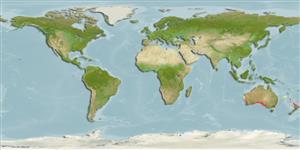Teleostei (teleosts) >
Tetraodontiformes (Puffers and filefishes) >
Monacanthidae (Filefishes)
Eponymy: Jean Jacques Victor Ayraud (1789–1821) was a naval surgeon who died in the Maritime Hospital at Fort-Royal, Martinique. [...] (Ref. 128868), visit book page.
More on authors: Quoy & Gaimard.
Environment: milieu / climate zone / depth range / distribution range
Ecology
Marine; demersal; depth range 0 - 360 m (Ref. 9563), usually 0 - 200 m (Ref. 6390). Subtropical; 22°S - 39°S
Eastern Indian Ocean: southern Australia, from Western Australia to New South Wales. The species is considered to be endemic to Australia, although a single specimen has been reported from New Zealand (Ref. 30464).
Length at first maturity / Size / Weight / Age
Maturity: Lm ?, range 37 - ? cm
Max length : 100.0 cm TL male/unsexed; (Ref. 9563); max. published weight: 3.5 kg (Ref. 27296); max. reported age: 9 years (Ref. 30466)
Dorsal spines (total): 2; Dorsal soft rays (total): 30 - 36; Anal spines: 0; Anal soft rays: 30 - 34. Whitish, pale yellowish brown, pale greyish brown or reddish, often with four brown stripes along sides; second dorsal and anal fins yellow; caudal fin rays yellowish brown, intervening membranes dusky. Pelvic fins rudimentary (Ref. 33839).
Adults are found on the continental shelf and slope, while juveniles school seasonally in inshore waters (Ref. 9563). Juvenile ocean jackets have been caught in seagrass, over bare sand and on rocky reefs (Ref. 6390). Adults however, tend to be absent from seagrass areas (Ref. 6390). Are carnivorous, feeding mainly on salps. Other food items in the diet include gastropod mollusks, crustaceans and fish (Ref. 30465). Sold as fresh trunks (Ref. 6390).
Assumed nonguarder because of high fecundity (RF).
May, J.L. and J.G.H. Maxwell, 1986. Trawl fish from temperate waters of Australia. CSIRO Division of Fisheries Research, Tasmania. 492 p. (Ref. 9563)
IUCN Red List Status (Ref. 130435: Version 2024-1)
Threat to humans
Harmless
Human uses
Fisheries: commercial
Tools
Special reports
Download XML
Internet sources
Estimates based on models
Preferred temperature (Ref.
123201): 15.3 - 21.2, mean 17.9 °C (based on 422 cells).
Phylogenetic diversity index (Ref.
82804): PD
50 = 1.0000 [Uniqueness, from 0.5 = low to 2.0 = high].
Bayesian length-weight: a=0.01122 (0.00653 - 0.01928), b=2.84 (2.69 - 2.99), in cm total length, based on LWR estimates for this species & (Sub)family-body (Ref.
93245).
Trophic level (Ref.
69278): 3.7 ±0.60 se; based on food items.
Generation time: 6.9 ( na - na) years. Estimated as median ln(3)/K based on 1
growth studies.
Resilience (Ref.
120179): Medium, minimum population doubling time 1.4 - 4.4 years (tm=2-4; tmax=9; Fec=700,000).
Fishing Vulnerability (Ref.
59153): High vulnerability (56 of 100).
Nutrients (Ref.
124155): Calcium = 33.6 [12.7, 95.1] mg/100g; Iron = 0.875 [0.402, 2.209] mg/100g; Protein = 18.4 [16.2, 20.6] %; Omega3 = 0.27 [0.12, 0.57] g/100g; Selenium = 49 [20, 120] μg/100g; VitaminA = 5.33 [1.45, 19.80] μg/100g; Zinc = 0.488 [0.308, 0.791] mg/100g (wet weight);
